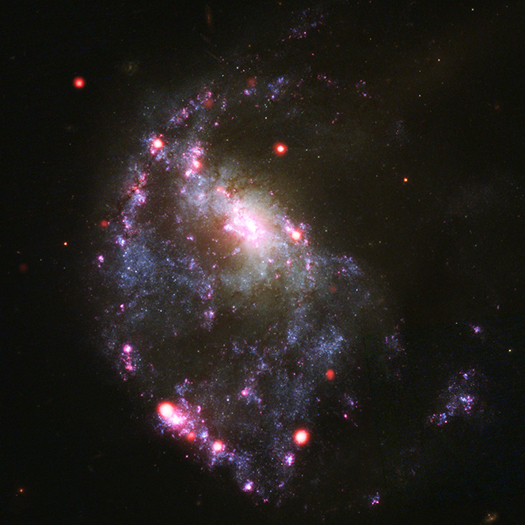Searching for the Best Black Hole Recipe
In this holiday season of home cooking and carefully-honed recipes, some astronomers are asking: what is the best mix of ingredients for stars to make the largest number of plump black holes?
They are tackling this problem by studying the number of black holes in galaxies with different compositions. One of these galaxies, the ring galaxy NGC 922, is seen in this composite image containing X-rays from NASA's Chandra X-ray Observatory (red) and optical data from the Hubble Space Telescope (appearing as pink, yellow and blue).
NGC 922 was formed by the collision between two galaxies - one seen in this image and another located outside the field of view. This collision triggered the formation of new stars in the shape of a ring. Some of these were massive stars that evolved and collapsed to form black holes.
Most of the bright X-ray sources in Chandra's image of NGC 922 are black holes pulling material in from the winds of massive companion stars. Seven of these are what astronomers classify as "ultraluminous X-ray sources" (ULXs). These are thought to contain stellar-mass black holes that are at least ten times more massive than the sun, which places them in the upper range for this class of black hole. They are a different class from the supermassive black holes found at the centers of galaxies, which are millions to billions of times the mass of the sun.
Theoretical work suggests that the most massive stellar-mass black holes should form in environments containing a relatively small fraction of elements heavier than hydrogen and helium, called “metals†by astronomers. In massive stars, the processes that drive matter away from the stars in stellar winds work less efficiently if the fraction of metals is smaller. Thus, stars with fewer of these metals among their ingredients should lose less of their mass through winds as they evolve. A consequence of this reduced mass loss is that a larger proportion of massive stars will collapse to form black holes when their nuclear fuel is exhausted. This theory appeared to be supported by the detection of a large number (12) of ULXs in the Cartwheel galaxy, where stars typically contain only about 30% of the metals found in the sun.
More at http://chandra.harvard.edu/photo/2012/ngc922/
-Megan Watzke, CXC
Category:
- Log in to post comments

